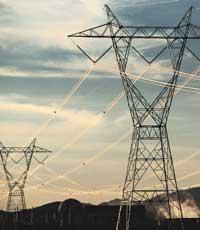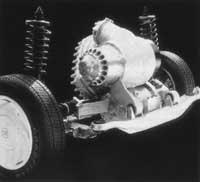Combined cycle and IGCC power plants
2001/05/01 Astobiza, Amaia Iturria: Elhuyar aldizkaria
Conventional thermal power plants use steam turbines to produce electrical energy. In the combined cycle plants, the steam turbine is combined with the gas turbine. In both facilities, the most used fuels are coal, heavy oils and natural gas. Urban and plant waste, fuel oil, diesel, biogas, etc. can also be used.
In the combined cycle plants, the fuel is burned and the gas produced is powered by the gas turbine. This gas turbine, in turn, acts on the generator and electricity is obtained. But the process doesn't end there. It is used to recover heat from gas turbine exhaust gases and evaporate water. Water vapor then affects the steam turbine, which acts on the generator and eventually produces electricity. Therefore, electricity is obtained in two points.
After the separation between conventional thermal power plants and combined cycle power plants, the question comes by itself, what advantage does the second have over the previous one? Thermal power plants have a great technological limitation, since the performance of current installations cannot exceed 42%. Conversely, when the conventional boiler is replaced by a set of gas turbines and recovery boilers, the thermal performance of the entire facility and the electrical power generated increase.
For a better understanding of the combined cycle installation we will use the side image. This scheme shows a pressure boiler and a condensation steam turbine. This is the simplest cycle used in combined cycle plants.
The turbine shown in the image consumes natural gas, but there is also liquid fuel and coal prepared to burn. However, the gas turbine is the most useful of all, since it has an energy distribution for every 100 units of fuel captured: electric power generation (between 25 and 35% of the total), high-temperature output gases (between 55 and 75% of the total) and certain losses by thermal radiation, lubricant oil cooling, etc.
As already indicated, the gas burned in the burner and produced affects the gas turbine. The outlet gas is then used as a heat source for water evaporation. The output gas temperature ranges from 440 to 550°C. In order to recover this heat energy, the gases are introduced into the recovery boiler. The recovery boiler is a heat exchanger. In it the gases supply their heat energy to the feed water, which allows the evaporation of water.
The structure of this intermediate heat exchanger is the same as that of conventional boilers. The main components are the economizer, evaporation tubes and the overheat. In the economizer, the feed water is heated almost to the evaporation temperature. The evaporation tubes then receive the water from the steam tank, generate the saturated steam and enter the warehouse again. Finally, the overheated steam is generated that is sent to the turbine in the overheat.
Gas and superheated steam are extracted from the boiler. The gas leaves the chimney, losing most of the heat energy. Steam enters the steam turbine. High pressure and temperature steam expands to lower atmospheric pressure and affects the turbine arms. Finally, the turbine acts on the generator and the mechanical energy is transformed into electrical energy.
The steam coming out of the turbine is at very low pressure and temperature due to the exhaustion of its energy during the expansion. However, it remains in a state of steam. Since the central water circuit is closed cycle, it is necessary that the steam is water again in order to enter the boiler feed water pump. To do this, the steam is inserted into the condenser of the plant. The capacitor is a large heat exchanger. There the steam cools and liquidates. The heat released during this process is transferred to the external cooling flow. River, lake or sea water is used as a cooling fluid. When the power plant is away from water sources, on the contrary, air is used to cool the condenser. In these cases it is necessary to build cooling towers. Structures similar to concrete chimneys are spacious and increase the cost of the central.
The parameter that indicates the efficiency of the combined cycle is the overall electrical performance of the cycle, that is, the parameter that considers the cycle as a whole. Fuel consumption is carried out only in the gas turbine (Q) and electricity is generated in two points: in the gas turbine (E) and in the steam turbine (ELT). Therefore, the cycle performance is:
h = Cycle/Qcycle = (E+MST)/Q
The performance can be around 50-65% (remember that the conventional thermal power plant ranges from 37% to 42%). As you can see, the difference between the two is evident. However, keep in mind that the combined cycle requires greater investment.
But the combined cycle described has two limitations. On the one hand, the steam flow that can be generated by recovering the heat from the gas turbine outlet gases is less than the steam turbine needs. On the other hand, the temperature of the overheated steam is very high and the difference between the gas outlet temperature of the gas turbine and the steam temperature is not enough for the heat exchange to occur satisfactorily.
Post-combustion and periodic combustion engines are used to improve the performance of the plant. Post-combustion is done by placing a burner at the entrance of the recovery boiler, at the point of pouring gases from the gas turbine, to increase the temperature of the gases and generate more steam. On the other hand, the replacement of gas turbines by periodic combustion engines increases the performance of the plant between 34 and 42%.
IGCC: integrated gasification combined cycle
This clean technology uses a mixture of gas, product of the gasification of fossil fuel, to feed the combined cycle of gas and steam turbines. The most commonly used fuels are heavy fractions (fuel oils) from coal and oil refining. The performance of this technology is very high, around 42%. In addition, emissions of pollutants into the atmosphere are considerably reduced, reaching 99% of coal sulfur and 90% of nitrogen compounds from exhaust gases and 35% of carbon dioxide.

Gai honi buruzko eduki gehiago
Elhuyarrek garatutako teknologia





